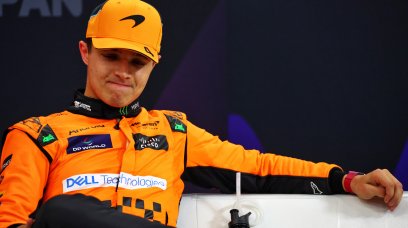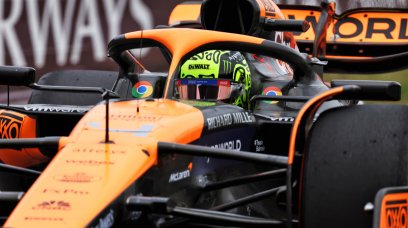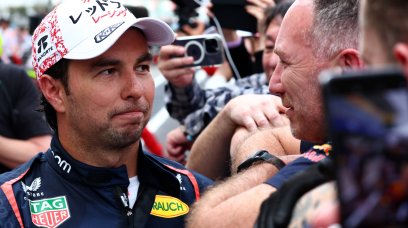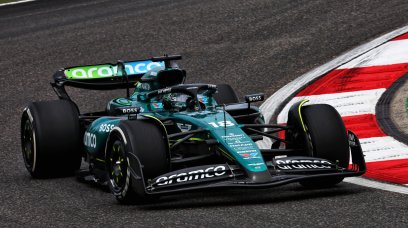When a car is decidedly dominant, there is an unwritten but always respected rule according to which the next car will simply be an evolution of it. The Red Bull RB18 undoubtedly represented the best interpretation of the 2022 F1 technical regulations, but also the one which was least affected by the 'rules changes' during the season (the implementation of Technical Directive No 39, which was enforced from the Belgian GP). A clear feature of this car was the excellent control of the phenomenon of ‘porpoising’ (aerodynamic jolts), which had reappeared on F1 cars this season as a legacy of the ground-effect single-seaters. The aerodynamic characteristics, in terms of the floor configuration for the RB18 along with the geometry and apparent simplicity of the front suspension, enabled the car to manage the effects that induced the jolts. This practically neutralised any bouncing often seen on the Ferrari or Mercedes. To simplify the concept there was almost a mechanical replica, in line with the current technical regulation, of the effects obtained through the (forbidden) adoption of active suspensions. The performance of the RB18, along with the Honda RA622H power unit, was based on the perfect integration between aerodynamic performance and vehicle dynamics. The factor that strongly linked these two elements was the progressive weight saving of the car, as it was over the 798kg limit at the start of the season.
The team of designers, led by Pierre Wache under the direct supervision of Adrian Newey, immediately intuited that one of the factors capable of generating performance was the controlled management of the stiffness for the central section of the bottom. While it was extremely important that the lateral peripheral sections did not undergo any deformation. This stopped the floor from generating an aerodynamic block with the very low ride heights, nor did it induce the breaking of the structure of the air flow under the car which would have increased the porpoising. Over the course of 2022, the team has placed the emphasis on weight reduction and on the progressive updating of the floor. It is useful to know that no less than sixteen versions of the floor were produced, clearly not all distinguishable by visible details. The information collected throughout the season, even in the case of little positive feedback, such as that of the debut of the floor introduced at Silverstone, enabled the technical office to lay the foundations of the RB19 - maintaining the same priorities that had characterised the development of the RB18.
At the heart of the RB19 project is the overall lightening of the car to immediately reach the minimum regulatory weight. The chassis in the lower-rear part will be shaped to allow for the partial housing of the cooling system.
Details of the RB19
While maintaining a strong "family feeling" with the previous car, next years challenger has followed two guidelines that will characterise its profound renewal. Weight reduction was the basis of the initial objectives of the project, already starting from the ideas, which were never materialised with its actual adoption, of the lightened chassis which had been widely discussed over the course of the summer. The monocoque of the RB19 will be characterised by a reduced weight compared to its predecessor of about three kilograms. The floor, driven by the new regulation where the “elbow” (the section connecting with the venturi channels) is raised by 10mm and the side profile in front of the rear wheels raised by 15mm, will also be lighter than the previous one, while maintaining a high degree of stiffness in relation to the shape of the sides, which will prevent deformation in the peripheral portions. The gearbox case and placement of the suspension elements, should be characterised by a lower narrowing, increasing the section of the lower Venturi channels. In terms of upper aerodynamics, the general layout of the sidepods, while maintaining strong points of contact with the 2022 model, will be characterised by a refinement of the cut-outs under the sidepods, which create a 'double floor' effect. There will be an extension towards the rear of these cut-outs, at the base of the sidepods. In appearance the RB19 should not surprise in terms of shape, with the RB18 construction solutions and vehicle dynamics remaining similar, but they will make a very profound evolution.
RB19 side view
The similarities between the 2023 single-seater (RB19) and the previous one will be noticeable. Highlighted in the image above is the profile of the channel underneath the sidepod, which will be more extreme towards the rear.
Sidepod inlets
The sidepods will maintain the characteristic shape of the squared inlets with a lower lip that formed the front upper edge of the underside of the sidepod channel.
Floor
As on the RB18 (see Silverstone evolution drawing) the floor is the basis of the aerodynamic concept of the RB19. The areas of greatest intervention concerns the central area, following the reduction of flexibility allowed by the new rules, and in the elbow of the diffuser. From rumours, it seems, engineers have managed to keep the weight of this element lower than the latest version in 2022.
Most read


















